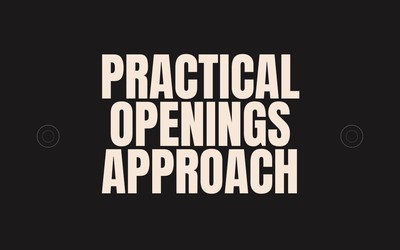
Ryan Velez
Plateau vs Consistency
How can you become a more consistent player?Plateau vs Consistency
The majority of chess players aspire to play more consistently, but those same players do not take pride in being on a rating plateau. What most people do not consider is these two scenarios are the same thing.
Plateau
The flatter parts of a rating graph
Consistency
The balance between winning and losing, at any level.
Anytime you win around 50 - 53% of your games, you are maintaining your rating. If you do this for an extended period of time, you are on a plateau. Here is an example:

A 100 point improvement from 2350 to 2450 during October 2023 - February 2024
Plateau periods are in yellow, and they appear like stairs. For example, the third plateau is well above the first one. People always celebrate peak rating and brilliant moves, but they complain about backsliding and slumps. Yet, I rarely see plateau’s discussed, and what we can learn from them:
Plateau periods ...
- ... involve winning and losing
- ... represent the longest periods of consistent play
- ... are a true measure of average strength
- ... are the step before improvement
Consistency involves losing, so why do I want to be consistent?
When people express desire to play more consistently, they do not realize consistent play involves losing. The purpose of learning to be a consistent player is to hold yourself in a rating category. Consistent players are also primed for improvement.

When you backslide, consistent play restores you. No matter what, your rating will naturally return to where you are most consistent. Surging above your rating and immediately backsliding means you had a streak of games that aligned with your knowledge base, but you did not really improve. Reaching, and holding, a new rating category is a true measure of progress, and is what should be celebrated. Most people celebrate rating peaks, but this is often premature due to an inability to demonstrate consistency at the newly achieved level.
How do I become more consistent?
Johannes Zukertort rightly said “Chess is the struggle against error.” Every misstep in chess is an error, and questioning those errors, and discovering why they are errors, and how to exploit those errors, improves decision making ability. The key to consistent play rests in limiting errors:
- Make fewer errors
- Make smaller errors
- Make hidden errors
Fewer Errors
To make fewer errors, you must understand different kinds of errors by answering questions. Here are examples:
- Why does dropping a piece hurt my position?
- Why is attacking with one piece not a good strategy?
- Why is h3 a poor move to play?
- Why is it harmful to move the same piece repeatedly?
Many more questions exist, but you get the idea. Making fewer errors means you have answered many of these kinds of questions.
Smaller Errors
Making smaller errors means limiting huge errors first, then focusing on smaller errors later. Playing h3 is less likely to be exploited than hanging your queen, for example. Here are common big errors for different levels of chess:
Low Level (Beginner - 1000)
Hanging checkmate
Hanging pieces
Drawing won games
Relying on trap openings to climb the rating ladder
Intermediate Level (1000 - 1500)
Ignoring the opponent’s piece coordination
Calculating only 2 moves deep or less
Memorizing openings instead of understanding opening principles
Not learning enough endgames
High Level (1500 - 2100)
Creating strategically lost plans
Forcing attacks in calm positions
Not reviewing complex endgames annually (or at all)
Sacrificing too willingly

Other big errors exist, but this list covers a lot of ground. Once you minimize bigger errors, you can then focus on smaller errors. Smaller errors require skill to exploit, and often you must exploit multiple smaller errors to gain an advantage. Here are examples of smaller errors:
- Wasting 1 tempo
- Playing h3
- Being down 1 pawn
- Having doubled c-pawns
- Having an isolated pawn
- Conceding the bishop pair
- Making passive moves
- Favoring / overvaluing a type of piece
Any of these errors can be a huge issue in the right position. But in every day play, these issues are not enough on their own to win games (most of the time). They usually require an additional error or two to become an insurmountable advantage. Additionally, these errors require skill to exploit.
For example, if you concede the bishop pair, it means the opponent may be able to generate unstoppable bishop activity. But, that requires many moves, and it requires a clear way to avoid a bishop trade, which is not always so easy to do. By making smaller errors, and reducing larger errors, you stabilize your rating and become more consistent.
Hidden Errors
A hanging queen that can be captured is directly observable, and does not require calculation. Hidden errors exist in calculation, and cannot be physically seen with your eyes until they are present on the board. When your errors are mostly concealed in calculation, you become more difficult to defeat.
I always teach that bad moves have good features, and good moves have bad features. This means that if a bad move is not punished, because the proper punishment was difficult to calculate or foresee, then that move’s good features will shine (and win).

Black to move (White just played 1.Rfe1??)
Playing 1.Rfe1 is a bad decision. But let’s break it down into analysis layers:
The move 1.Rfe1 ...
- ... allows Bxe5, which is good for black
- ... supports the passed e5-pawn after 1...Bxe5 2.fxe5
- ... avoids a rook trade along the f-file after 1...Bxe5 2.fxe5
- ... double / triple covers the e4-square, preventing moves like Be4 that may interfere with the e5 pawn’s march forward
- ... is also extremely difficult for black to attack or displace
This bad Rfe1 move has many alluring features, and these features can produce a winning scenario if black does not exploit the move properly. Here is an example where black fails to exploit the problem properly:
Here is the same position, except black succeeds in exploiting the problem:
Exploiting errors that require precise moves and proper plans is much harder than trying to get away with hanging a queen. When your error and its consequence exist on the board simultaneously, it becomes much easier to defeat you. Therefore, when your errors become hidden errors, you are improving as a chess player, and can offer more resistance against an opponent.
8 Tips for Consistent Play
These tips are helpful for
- Preventing backsliding
- Getting out of slumps
- Maintaining an achieved level of play
These tips are not intended to be advice to follow indefinitely, because doing so would mean you never leave your comfort zone.
However, the comfort zone approach is reasonable while you are learning new skills behind the scenes. For example, if you wish to switch your opening, you may need time to learn the opening before implementing it. Therefore, use some of the techniques below until your confidence with whatever skill you are learning is ready to be put into practice.
1. Do not make sacrifices with unverifiable results
Only make sacrifices that
- Force checkmate
- Force a favorable stalemate
- Immediately (re)gain material
- Use the desperado tactic.
If you cannot verify the sacrifice’s results, you risk losing your game. Unforced sacrifices, when there are other paths forward, can also lead you astray. To be even more clear, you will want to avoid the following kinds of sacrifices when your goal is to increase consistency:
- Clearance sacrifices
- Exchange sacrifices
- Positional sacrifices
- Deflection / Attraction Tactics
These sacrifices are all good to do if you can clearly calculate the consequences. However, if after calculating and left you are left with uncertainty, or a mental fog, then avoid playing these kinds of moves.
2. Play the same openings repeatedly, and improve upon them
Much of chess is about pattern recognition, and if you wish to stabilize yourself, relying on familiar patterns will help with any stabilization measures you may be taking. Many people want to switch openings to trick people or to change things up. However, when trying to maintain your level, it is better to see familiar positions than unfamiliar ones.
When your opening goes awry, figure out what went wrong and improve. You might need to make the same mistake two or three times. But if you keep fine tuning your openings, you will be harder to defeat during the first stage of the game.
3. Play solid, orthodox, reputable openings
Reputable orthodox openings honed and fine-tuned over time will serve you better than constantly exploring new openings.
Trap openings and unorthodox openings make you a very exploitable player, and should be avoided. Gambit lines can be acceptable, but you need to learn them well.
4. Regularly solve tactics, especially within the openings you play
Minimizing losses due to tactics is an eternal struggle for all chess players. I recommend solving
- tactics by theme
- 25+ in a row before switching themes
- 25+ in one sitting
Solving one tactic here and there is not very useful when building pattern recognition skills. Lichess also offers opening themes for tactics, which allows you to double up your tactics and openings training.
5. Learn all the basic endgames, and be able to do them with a clock time of 1 second with 5 second delay (or increment).
Specifically, learn the following:
- Basic 2-piece checkmates
- Basic king and pawn endgames
- Favorably imbalanced endgmes
- The basics of pure endgames
Pure endgames are when both sides have the same piece(s), and some accompanying pawns. Learning the basics of these endgames will inform your endgame play at all levels.

It is also good to learn favorably imbalanced endgames like
- KQ vs KN
- KQ vs KB
- KR vs K+1 pawn
- KR+1 vs KR
- KBB vs K
- KBB vs K+1
- Etc...
Many people do not cover these endgames in their training, and often end up drawing won positions. Being able to play consistently, at all levels, means knowing how to win these sorts of positions.
6. Choose tournaments and sections that match your skill level
When entering a tournament, you often have two choices:
- Play in the lowest category you qualify for
- Play up in a higher category
When you are on a plateau, I recommend playing in the lowest category you qualify for because the simplest way to prove yourself is to exit a rating category by beating players in that rating category. If you cannot maintain a win rate above 50 - 53%, then playing up won’t help much.
7. Combat Engine Dependency
Engine Dependency often lays the groundwork for backsliding and slumps because you don’t think for yourself. I have explored this topic in deep detail here.
8. Going over games properly
There is a lot of advice on going over your games. For anyone rated 2100 and below, I recommend Layered Analysis, which I discussed in detail here. In short, you break games down into 3 to 5 themes, and go over each theme individually. The purpose of it is to identify the key themes of the game, and then look at how those themes interact.
Plateau vs Consistency Summary
Understanding consistent play and plateaus are the same thing is critical for development. Use your plateau periods to learn new skills, and actively try to minimize risk in your decision making (ie: move selection). People who are plateaued are primed for improvement, and minimizing risk while introducing newly learned skills can bring you to the next level.
Supporting Me
My Exploring Chess blog has the following goals:
- They are always a full lesson
- They will not contain scandals or sensationalism
- They are never going to be ads in disguise
My personal goals are as follows:
- Produce high quality content
- Answer questions beginners have
- Dive deeply into each topic
If you are able to encourage me to continue, go here. Otherwise, enjoy all of my content for free.

More blog posts by RyanVelez

Practical Openings Approach
This post is for people who need to learn openings, but struggle.
Resigning Strategy
This article is for anyone who wants to understand the strategy of resigning, at both low and high l…
I want to improve, but I'm busy !!!
This article is for people who want to improve but are busy, and for anyone who wants to know how to…